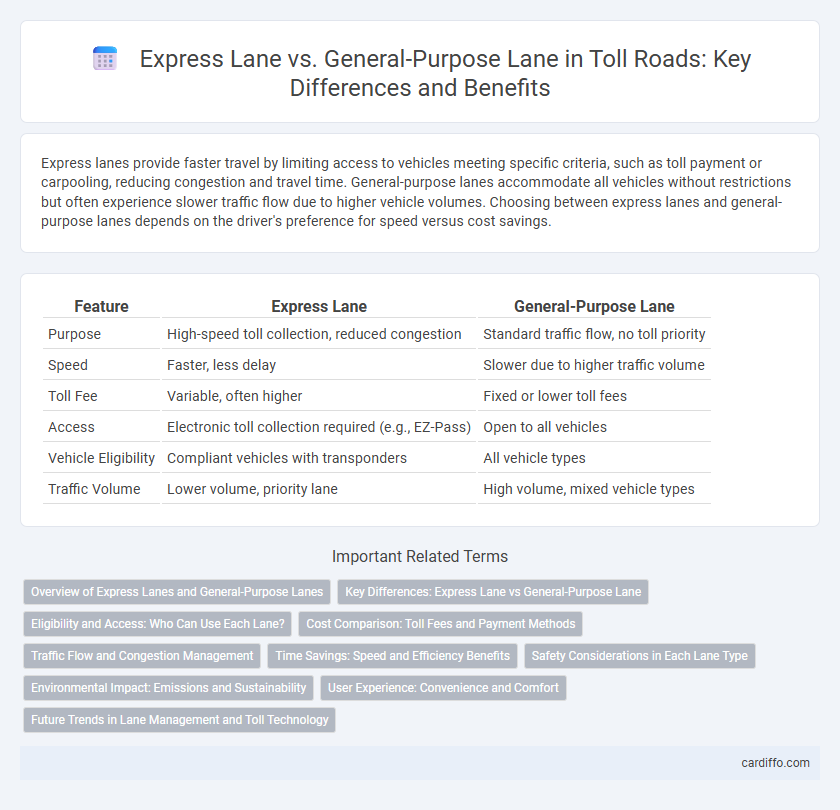Express lanes provide faster travel by limiting access to vehicles meeting specific criteria, such as toll payment or carpooling, reducing congestion and travel time. General-purpose lanes accommodate all vehicles without restrictions but often experience slower traffic flow due to higher vehicle volumes. Choosing between express lanes and general-purpose lanes depends on the driver's preference for speed versus cost savings.
Table of Comparison
| Feature | Express Lane | General-Purpose Lane |
|---|---|---|
| Purpose | High-speed toll collection, reduced congestion | Standard traffic flow, no toll priority |
| Speed | Faster, less delay | Slower due to higher traffic volume |
| Toll Fee | Variable, often higher | Fixed or lower toll fees |
| Access | Electronic toll collection required (e.g., EZ-Pass) | Open to all vehicles |
| Vehicle Eligibility | Compliant vehicles with transponders | All vehicle types |
| Traffic Volume | Lower volume, priority lane | High volume, mixed vehicle types |
Overview of Express Lanes and General-Purpose Lanes
Express lanes offer toll-based, managed traffic flow designed to reduce congestion and provide faster travel options by adjusting pricing based on demand, while general-purpose lanes remain free and open to all vehicles without occupancy or payment restrictions. Express lanes often use electronic tolling and real-time traffic monitoring to optimize capacity, contrasting with general-purpose lanes that handle standard traffic volumes at fixed capacity. This differentiation supports dynamic traffic management, improving overall roadway efficiency and commuter choice.
Key Differences: Express Lane vs General-Purpose Lane
Express lanes prioritize high-occupancy vehicles and toll-paying drivers, offering faster travel with dynamic toll pricing based on real-time traffic conditions. General-purpose lanes accommodate all vehicles without toll restrictions, often resulting in higher congestion and variable speeds. The express lane system optimizes traffic flow and reduces travel time by managing demand through pricing and vehicle eligibility criteria.
Eligibility and Access: Who Can Use Each Lane?
Express lanes are designed for vehicles that meet specific eligibility criteria, such as paying a toll electronically, carpooling with a minimum number of passengers, or using high-occupancy vehicle (HOV) permits, ensuring faster travel times. General-purpose lanes are open to all drivers without restrictions, providing standard access without toll charges or occupancy requirements. Eligibility for express lanes is often enforced through electronic transponders or license plate recognition, while general-purpose lanes operate without such controls.
Cost Comparison: Toll Fees and Payment Methods
Express lanes typically charge dynamic toll fees based on real-time traffic conditions, aiming to optimize traffic flow and reduce congestion, whereas general-purpose lanes usually have fixed or no tolls, making them more predictable but potentially slower. Payment methods for express lanes often include electronic toll collection systems like E-ZPass, FasTrak, or SunPass, enabling seamless, cashless travel, while general-purpose lanes may accept cash, cards, or electronic payments depending on the jurisdiction. The cost advantage of express lanes lies in the time savings, with toll fees varying from a few cents to several dollars per mile, compared to potentially longer delays and no toll costs in general-purpose lanes.
Traffic Flow and Congestion Management
Express lanes use dynamic pricing to regulate traffic flow, maintaining free-flow conditions by deterring congestion during peak hours. General-purpose lanes often experience variable speeds and bottlenecks due to unrestricted vehicle access and higher traffic volumes. Implementing express lanes enhances congestion management by allocating road space efficiently, reducing overall travel time and improving reliability for commuters.
Time Savings: Speed and Efficiency Benefits
Express lanes significantly reduce travel time by minimizing congestion through limited access and higher toll rates, allowing vehicles to maintain consistent speeds. General-purpose lanes often experience variable traffic volumes and frequent slowdowns, resulting in longer and less predictable travel times. The strategic use of express lanes enhances overall corridor efficiency, providing measurable time savings for commuters willing to pay for faster travel.
Safety Considerations in Each Lane Type
Express lanes typically feature controlled access and fewer entry points, reducing conflict zones and enhancing overall safety for high-speed traffic. General-purpose lanes accommodate diverse vehicle types and frequent merging, increasing the potential for collisions and requiring attentive driving. Safety measures such as clear signage, barrier separations, and speed regulation are crucial to mitigate risks unique to each lane type.
Environmental Impact: Emissions and Sustainability
Express lanes reduce vehicle idling and congestion, leading to lower emissions compared to general-purpose lanes that often experience stop-and-go traffic. The smoother traffic flow in express lanes contributes to improved fuel efficiency and decreased greenhouse gas output. Sustainable traffic management through express lanes supports urban air quality goals by minimizing pollutants from heavy traffic delays.
User Experience: Convenience and Comfort
Express lanes offer a significantly enhanced user experience by reducing wait times and providing smoother traffic flow compared to general-purpose lanes, resulting in greater convenience and comfort for drivers. These lanes often feature automated toll collection systems, minimizing stops and promoting consistent speeds that decrease driver stress and fatigue. In contrast, general-purpose lanes frequently experience congestion and slower processing at toll booths, leading to longer travel times and less comfort.
Future Trends in Lane Management and Toll Technology
Future trends in lane management emphasize the integration of advanced toll technologies such as dynamic pricing and real-time traffic analytics to enhance express lane efficiency. Express lanes are increasingly equipped with AI-powered sensors and automated payment systems that reduce congestion and optimize traffic flow. General-purpose lanes are expected to incorporate adaptive tolling strategies, balancing demand and improving overall roadway performance through seamless lane transitions.
Express lane vs General-purpose lane Infographic

 cardiffo.com
cardiffo.com